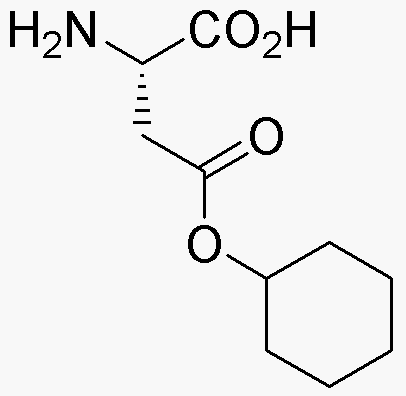L-Aspartic acid b-cyclohexyl ester is widely utilized in research focused on:
- Pharmaceutical Development: This compound serves as a key intermediate in the synthesis of various pharmaceuticals, particularly those targeting neurological disorders, enhancing drug efficacy and bioavailability.
- Biochemical Research: It is used in studies related to amino acid metabolism and protein synthesis, helping researchers understand cellular processes and develop new therapeutic strategies.
- Food Industry: The ester is explored as a flavor enhancer or additive, providing a unique taste profile while being safe for consumption, appealing to food manufacturers looking for natural ingredients.
- Cosmetic Formulations: Its properties make it suitable for use in skincare products, where it can improve hydration and skin texture, attracting cosmetic companies aiming for effective and gentle formulations.
- Polymer Science: The compound is investigated for its potential in creating biodegradable polymers, offering an eco-friendly alternative for industries focused on sustainability and reducing environmental impact.
General Information
Properties
Safety and Regulations
Applications
L-Aspartic acid b-cyclohexyl ester is widely utilized in research focused on:
- Pharmaceutical Development: This compound serves as a key intermediate in the synthesis of various pharmaceuticals, particularly those targeting neurological disorders, enhancing drug efficacy and bioavailability.
- Biochemical Research: It is used in studies related to amino acid metabolism and protein synthesis, helping researchers understand cellular processes and develop new therapeutic strategies.
- Food Industry: The ester is explored as a flavor enhancer or additive, providing a unique taste profile while being safe for consumption, appealing to food manufacturers looking for natural ingredients.
- Cosmetic Formulations: Its properties make it suitable for use in skincare products, where it can improve hydration and skin texture, attracting cosmetic companies aiming for effective and gentle formulations.
- Polymer Science: The compound is investigated for its potential in creating biodegradable polymers, offering an eco-friendly alternative for industries focused on sustainability and reducing environmental impact.
Documents
Safety Data Sheets (SDS)
The SDS provides comprehensive safety information on handling, storage, and disposal of the product.
Product Specification (PS)
The PS provides a comprehensive breakdown of the product’s properties, including chemical composition, physical state, purity, and storage requirements. It also details acceptable quality ranges and the product's intended applications.
Certificates of Analysis (COA)
Search for Certificates of Analysis (COA) by entering the products Lot Number. Lot and Batch Numbers can be found on a product’s label following the words ‘Lot’ or ‘Batch’.
Numéro de catalogue
Numéro de lot/série
Certificates Of Origin (COO)
This COO confirms the country where the product was manufactured, and also details the materials and components used in it and whether it is derived from natural, synthetic, or other specific sources. This certificate may be required for customs, trade, and regulatory compliance.
Numéro de catalogue
Numéro de lot/série
Safety Data Sheets (SDS)
The SDS provides comprehensive safety information on handling, storage, and disposal of the product.
DownloadProduct Specification (PS)
The PS provides a comprehensive breakdown of the product’s properties, including chemical composition, physical state, purity, and storage requirements. It also details acceptable quality ranges and the product's intended applications.
DownloadCertificates of Analysis (COA)
Search for Certificates of Analysis (COA) by entering the products Lot Number. Lot and Batch Numbers can be found on a product’s label following the words ‘Lot’ or ‘Batch’.
Numéro de catalogue
Numéro de lot/série
Certificates Of Origin (COO)
This COO confirms the country where the product was manufactured, and also details the materials and components used in it and whether it is derived from natural, synthetic, or other specific sources. This certificate may be required for customs, trade, and regulatory compliance.


